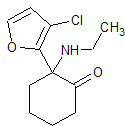rangrz
Bluelighter
has it been made, if so, is it similar to PCP
I am speaking of what would be called 1-(1-phenylcyclohexyl)piperazine
replacing the piperdine in PCP with piperazine.
just posting here to see if anyone knows if its been done, if so, the results of it, if not, any educated speculation on its effects/similarity to PCP.
I am speaking of what would be called 1-(1-phenylcyclohexyl)piperazine
replacing the piperdine in PCP with piperazine.
just posting here to see if anyone knows if its been done, if so, the results of it, if not, any educated speculation on its effects/similarity to PCP.




